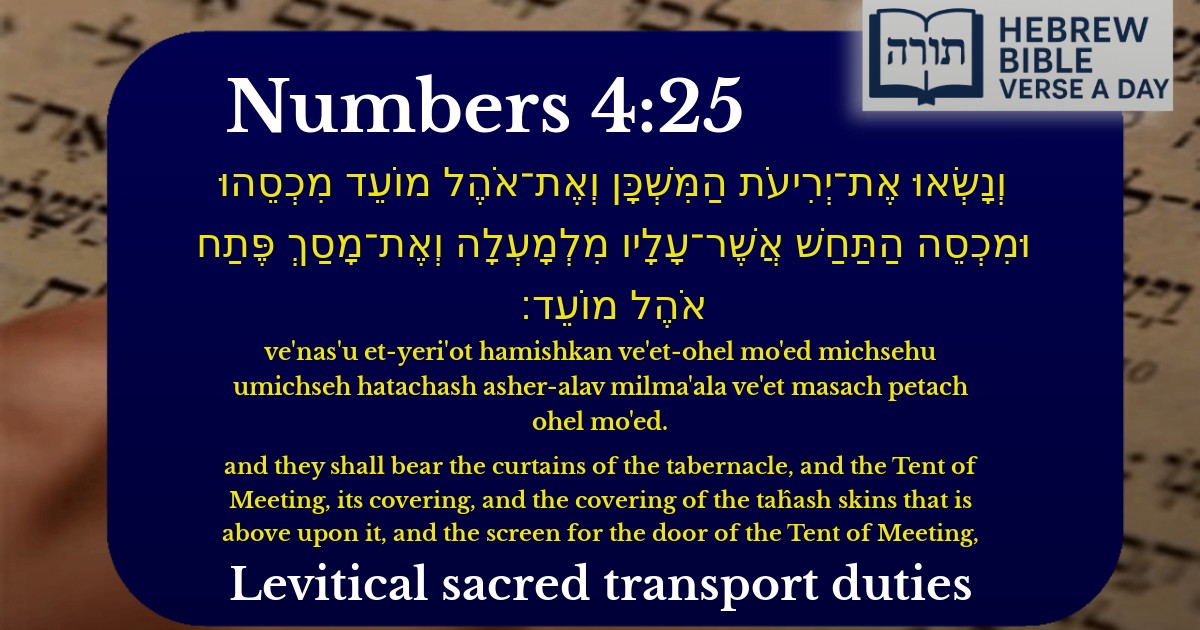Frequently Asked Questions
Q: What is the significance of the Tabernacle curtains mentioned in Numbers 4:25?
A: The curtains of the Tabernacle (Mishkan) were sacred coverings that symbolized the holiness and separation of the space where the Divine Presence dwelled. According to Rashi, these curtains were made with fine materials like wool and linen, representing the beauty and sanctity of the Mishkan. Their careful handling during transport, as described in this verse, teaches us the importance of treating holy objects with reverence.
Q: Why does the verse mention the 'Tent of Meeting' and its coverings?
A: The 'Tent of Meeting' (Ohel Moed) was the central place where Moses communicated with Hashem and where the Divine Presence rested. The coverings, including the taĥash skins (a rare, possibly mystical animal hide), protected the sacred structure. The Rambam explains that these details emphasize the meticulous care required in maintaining and transporting holy spaces, ensuring they remain pure and intact.
Q: What is the 'taĥash' covering mentioned in Numbers 4:25?
A: The taĥash was a unique, colorful animal whose skin was used as an outer covering for the Mishkan. The Talmud (Shabbat 28b) discusses its rarity and beauty, suggesting it was created specifically for this sacred purpose. Some Midrashim describe it as a miraculous creature that appeared only for the construction of the Mishkan and then vanished, highlighting the Divine Providence in its use.
Q: How does this verse apply to us today if we don’t have the Mishkan?
A: While we no longer have the physical Mishkan, the principles of reverence for holiness still apply. The Talmud (Berachot 8a) teaches that synagogues and study halls are considered 'miniature sanctuaries.' Just as the Levites carefully carried the Mishkan’s coverings, we must treat our places of prayer and Torah study with respect, cleanliness, and devotion.
Q: Who was responsible for carrying the Mishkan’s curtains and coverings?
A: The verse is part of the duties assigned to the Gershonite family of Levi (Numbers 4:21–28). Under Ithamar the Kohen’s supervision, they carried the Mishkan’s textiles—curtains, coverings, and screens. Rashi notes that this division of labor teaches the value of each person’s unique role in serving Hashem, whether through physical labor or spiritual leadership.


Overview of the Verse
The verse (Bamidbar 4:25) describes the duties of the Gershonite family of Levi'im in transporting the coverings and curtains of the Mishkan (Tabernacle) during the Israelites' travels in the wilderness. This task was part of their sacred service under the direction of Aharon and his sons (Bamidbar 4:27).
Rashi's Commentary
Rashi explains that the "curtains of the tabernacle" (יְרִיעֹת הַמִּשְׁכָּן) refer to the ten curtains made of fine twisted linen, blue, purple, and scarlet, with cherubim woven into them (Shemot 26:1). The "covering of the taĥash skins" (מִכְסֵה הַתַּחַשׁ) was the outermost protective layer, as described in Shemot 26:14. Rashi emphasizes that the Gershonites were responsible only for transporting these items—not for setting them up, which was the role of the Kohanim.
Rambam's Perspective
In Hilchot Kelei HaMikdash (Laws of Temple Vessels), Rambam discusses how the Levitical duties were divided among the families of Gershon, Kehat, and Merari. The Gershonites' role in carrying the Mishkan's coverings was distinct from the Kehatites, who carried the holy vessels, and the Merarites, who carried the structural components. This division ensured an orderly and respectful transport of the Mishkan's components.
Midrashic Insights
Symbolism of the Coverings
The Kli Yakar (R' Shlomo Ephraim Luntschitz) observes that the layers of the Mishkan's coverings—linen, goat hair, ram skins, and taĥash skins—represent different levels of spiritual elevation. The Gershonites' role in guarding these layers symbolizes the need to protect both the inner and outer dimensions of divine service.